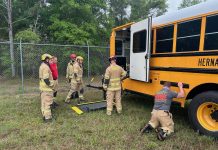California school districts have more information on what they need to do to equip all school buses with child reminder systems, before the start of next school year, following the California Highway Patrol’s release of new regulations prompted by the death of a special needs student in 2015.
The regulation filed by CHP on Dec. 28 and approved by the Secretary of State requires all 24,000 school buses—newly purchased and already in operation—to have “Child Safety Alert Systems” that prompt school bus drivers via an alarm to check the bus for sleeping students or those who otherwise did not get off at their assigned stop.
The CHP told School Transportation News last summer that subsection 1294 of Title 13 would not “grandfather in” any existing technology.
The new regulations require a shut-off location at the rear of each school bus where the school bus driver must deactivate an audible and/or visible alarm following a sweep of the bus. The system does not arm itself for the first three minutes of vehicle movement, or once the vehicle reaches a speed of 10 mph, whichever comes first.
The alarm consists of an audible tone, a flashing light visible from 50 feet away or both that can be connected to the school bus flashing red light signal system but cannot sound the alarms during normal loading and unloading of students.
“The whole purpose is to look for unattended children,” said Anna Borges, state director of student transportation at the California Department of Education.
CHP also noted that the key must not remain in the ignition during the check. Where possible, a school bus dome light should remain illuminated to assist the driver in completing the check. If the school bus is unable to provide a secondary light for the check, the school bus driver is responsible for ensuring it.
Borges pointed out that individual districts have already implemented best-practices of providing drivers with an additional light such as a flashlight for conducting inspections during pre-dawn morning hours or at night.
During pilot tests conducted last year, Child Check-Mate Systems found additional relays or switches may need to be installed to meet the regulations, said company spokeswoman Kaitlynne Monaghan. “An installer wouldn’t know what is needed until getting into the vehicle and taking a look at it,” she told STN.
She added that Child Check-Mate has always been able to make connections to the doors and dome lights as well as to accommodate for state law that requires school bus drivers to leave the bus, with the keys no longer in the ignition, to escort your children across the road at bus stops.
“What is new to us is monitoring the parking brake, and at this time that can be achieved by installing a switch,” Monaghan said.
Zonar said it is also configuring its Electronic Verified Inspection Reporting solution, or EVIR, to adhere to the driver shut-off requirement. Fred Fakkema, the company’s VP of compliance, added that Zonar is partnering with Child Check-Mate to add an audible tone or flashing lights visible from at least 50 feet, which is also required by the Title 13 update, as well as an optional digital alert of incidents where drivers fail to follow procedure.
“The digital alert, while not currently required, is important because there are and will be incidents where an alarm sounds in a large bus yard, making identifying the appropriate bus potentially difficult,” Fakkema explained. “Additionally, those buses are often parked at a different location than the bus garage, and potentially no one would ever know the system was activated without an alert.”
He added that an additional alert will be sent to dispatch identifying exactly which bus was not checked properly and where it is located. Fakkema also said the recording of alerts can be used by fleet managers to determine how often incidents occur and which drivers operate those buses to enhance training and provide “better and consistent child checks.”
The regulation arose from the Paul Lee Law, passed by the state legislature and signed by Gov. Jerry Brown on Sept. 28, 2016, one year after the Sept. 11, 2015 death of a 19-year-old Hun Joon “Paul” Lee. Lee was a nonverbal student with autism who died after his school bus driver left him alone on the school bus for eight hours in 90-degree-plus temperatures.
The driver, Armando Ramirez, pleaded guilty to felony dependent adult abuse resulting in death last August and is serving two years in prison. The bus contractor that employed him, Pupil Transportation Cooperative, was ordered to pay a $23.5 million wrongful death settlement to the Lee family.
The contractor, a government agency, is in turn suing the Whittier Union High School District to recoup some of the money, claiming the district was also at fault for failing to notify Lee’s parents that the boy never showed up for school that day.
















